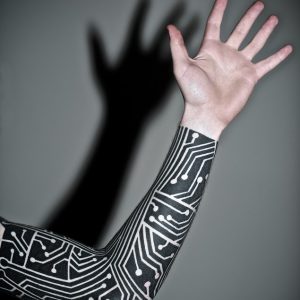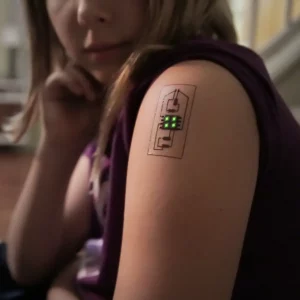Tattoo… wearables?
While the world is on a general ChatGPT and AI craze, let’s not forget what algorithms need to function – data. In order to generate and collect data, you also need hardware tech. Medicine and health care may and even consumer fitness are bound to see an AI revolution (for better or worse, but hopefully, mostly better). And, the technology is finding an (unlikely?) ally in tattooing.
Sure, these are not your ordinary ink tattoos, but nonetheless. Let’s take a look at electronic tattoos and how they can help people with various conditions increase their quality of life and healthspan and athletes (or your average crossfitter) improve their performance.
First of all… what are they? Electronic tattoos, also known as e-tattoos or smart tattoos, are a type of wearable technology. They are soft devices with integrated sensors or circuits that attach to the skin, transmitting data wirelessly to a receiver, such as a smartphone app. The receiving device will then analyse and track the information.

E-tattoos can be fitted anywhere and measure things such as sweat composition, blood pressure, hormones and chemicals. One could say that they look like really thin stickers. Some are made from conductive materials, such as carbon or conductive polymers. These can measure subtle electrical signals that the body produces when we move or even think.
Following the body’s contours
Of course, fitting sensors to the body to measure biomarkers is nothing new, as any diabetic or just your general Apple Watch wearer will tell you. However, as any tattoo artist knows, following anatomical features precisely is tricky. What is different about the tattoo wearables is that they can be positioned in places on the body that are difficult to fit more rigid pieces onto.

Thus, they can also be more discreet and comfortable compared to traditional wearable measuring and data-collecting devices. They are also designed to be worn for extended periods of time, including sleep. This allows researchers or physicians to collect data that would previously have been very tricky or required a lab setting to track. The technology could also be used to monitor a patient at home in real time instead of keeping them in the hospital for observation.
Haptic feedback to your skin
More advanced applications of electronic tattoos would also allow for haptic feedback, with tiny motors offering sensory input for the user (you know, like in the PS5 DualSense controller). For instance, this could allow for real-time adjustment of exercise intensity, helping an athlete reach their full potential during a training session or immediately warn someone that their blood pressure is rising.
While electronic tattoos hold great promise when it comes to enhancing the human experience through wearable technology, they are still relatively new and not very widespread. One of the challenges is that the materials lose their connectivity relatively quickly, often within a matter of days. As such, bringing the cost of producing electronic tattoos down will be essential in bringing them to a broader market. Anyone imagining Apple releasing iInk anytime soon?
